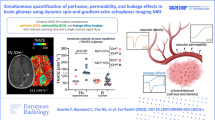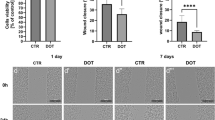No Heading
Purpose.
To investigate the pharmacokinetics, long-term tissue retention of Gd(III) ions, and magnetic resonance imaging (MRI) contrast enhancement of extracellular biodegradable macromolecular Gd(III) complexes, (Gd-DTPA)-cystamine copolymers (GDCC), of different molecular weights.
Methods.
The pharmacokinetics of blood clearance and long-term Gd(III) retention of GDCC were investigated in Sprague-Dawley rats. Pharmacokinetic parameters were calculated by using a two-compartment model. The blood pool contrast enhancement of GDCC was evaluated in Sprague-Dawley rats on a Siemens Trio 3T MR scanner. Gd-(DTPA-BMA) was used as a control.
Results.
The α phase half-life of Gd-(DTPA-BMA) and GDCC with molecular weights of 18,000 (GDCC-18) and 60,000 Da (GDCC-60) was 0.48 ± 0.16 min, 1.08 ± 0.24 min, and 1.74 ± 0.57 min, and the β phase half-life was 21.2 ± 5.5 min, 26.5 ± 5.9 min, and 53.7 ± 15.9 min, respectively. GDCC had minimal long-term Gd tissue retention comparable to that of Gd-(DTPA-BMA). GDCC resulted in more significant contrast enhancement in the blood pool than Gd-(DTPA-BMA).
Conclusions.
GDCC provides a prolonged blood pool retention time for effective MRI contrast enhancement and then clears rapidly with minimal accumulation of Gd (III) ions. It is promising for further development as a blood pool MRI contrast agent.
Similar content being viewed by others
References
1. P. Caravan, J. J. Ellison, T. J. McMurry, and R. B. Lauffer. Gadolinium(III) chelates as MRI contrast agents: structure, dynamics, and applications. Chem. Rev. 99:2293–2352 (1999).
2. L. E. Gerlowski and R. K. Jain. Microvascular permeability of normal and neoplastic tissues. Microvasc. Res. 31:288–305 (1986).
3. H. Maeda, L. W. Seymour, and Y. Miyamoto. Conjugates of anticancer agents and polymers: advantages of macromolecular therapeutics in vivo. Bioconjug. Chem. 3:351–362 (1992).
4. R. C. Brasch. Rationale and applications for macromolecular Gd-based contrast agents. Magn. Reson. Med. 22:282–287 (1991).
5. V. P. Torchilin. Polymeric contrast agents for medical imaging. Curr. Pharm. Biotechnol. 1:183–215 (2000).
6. H. Kobayashi and M. W. Brechbiel. Dendrimer-based macromolecular MRI contrast agents: characteristics and application. Mol. Imaging 2:1–10 (2003).
7. R. Lauffer and T. J. Brady. Preparation and water relaxation properties of proteins labeled with paramagnetic metal chelates. Magn. Reson. Imaging 3:11–16 (1985).
8. G. Schuhmann-Giampieri, H. Schmitt-Willich, T. Frenzel, W. R. Press, and H. J. Weinmann. In vivo and in vitro evaluation of Gd-DTPA-polylysine as a macromolecular contrast agent for magnetic resonance imaging. Invest. Radiol. 26:969–974 (1991).
9. A. A. J. Bogdanov, R. Weissleder, H. W. Frank, A. V. Bogdanova, N. Nossif, B. K. Schaffer, E. Tsai, M. I. Papisov, and T. J. Brady. A new macromolecule as a contrast agent for MR angiography: preparation, properties, and animal studies. Radiology 187:701–706 (1993).
10. E. C. Wiener, M. W. Brechbiel, H. Brothers, R. L. Magin, O. A. Gansow, D. A. Tomalia, and P. C. Lauterbur. Dendrimer-based metal chelates: a new class of magnetic resonance imaging contrast agents. Magn. Reson. Med. 31:1–8 (1994).
11. D. L. Ladd, R. Hollister, X. Peng, D. Wei, G. Wu, D. Delecki, R. A. Snow, J. L. Toner, K. Kellar, J. Eck, V. C. Desai, G. Raymond, L. B. Kinter, T. S. Desser, and D. L. Rubin. Polymeric gadolinium chelate magnetic resonance imaging contrast agents: design, synthesis, and properties. Bioconjugate Chem. 10:361–370 (1999).
12. R. Weissleder, A. J. Bogdanov, C. H. Tung, and H. J. Weinmann. Size optimization of synthetic graft copolymers for in vivo angiogenesis imaging. Bioconjugate Chem. 12:213–219 (2001).
13. H. Kobayashi, S. Kawamoto, S. K. Jo, H. L. Bryant, M. W. J. Brechbiel, and R. A. Star. Macromolecular MRI contrast agents with small dendrimers: pharmacokinetic differences between sizes and cores. Bioconjug. Chem. 14:388–394 (2003).
14. H. Kobayashi, N. Sato, A. Hiraga, T. Saga, Y. Nakamoto, H. Ueda, J. Konishi, K. Togashi, and M. W. Brechbiel. 3D-micro-MR angiography of mice using macromolecular MR contrast agents with polyamidoamine dendrimer core with reference to their pharmacokinetic properties. Magn. Reson. Med. 45:454–460 (2001).
15. A. Gossmann, Y. Okuhata, D. M. Shames, T. H. Helbich, T. P. Roberts, M. F. Wendland, S. Huber, and R. C. Brasch. Prostate cancer tumor grade differentiation with dynamic contrast-enhanced MR imaging in the rat: comparison of macromolecular and small-molecular contrast media-preliminary experience. Radiology 213:265–272 (1999).
16. F. N. Franano, W. B. Edwards, M. J. Welch, M. W. Brechbiel, O. A. Gansow, and J. R. Duncan. Biodistribution and metabolism of targeted and nontargeted protein-chelate-gadolinium complexes: evidence for gadolinium dissociation in vitro and in vivo. Magn. Reson. Imaging 13:201–214 (1995).
17. S. J. Wang, M. Brechbiel, and E. C. Wiener. Characteristics of a new MRI contrast agent prepared from polypropyleneimine dendrimers, generation 2. Invest. Radiol. 38:662–668 (2003).
18. Z. R. Lu, D. L. Parker, K. C. Goodrich, X. Wang, J. G. Dalle, and H. R. Buswell. Extracellular biodegradable macromolecular gadolinium(III) complexes for MRI. Magn. Reson. Med. 51:27–34 (2004).
19. Taconic. Hematological charts & clinical chemistry values for Sprague Dawley rats in technical library, http://www.taconic.com/healthr/hematology/sdheme.htm.
20. D. J. Parmelee, R. C. Walovitch, H. S. Ouellet, and R. B. Lauffer. Preclinical evaluation of the pharmacokinetics, biodistribution, and elimination of MS-325, a blood pool agent for magnetic resonance imaging. Invest. Radiol. 32:741–747 (1997).
21. M. T. Vlaardingerbroek and J. A. den Boer. Magnetic Resonance Imaging, Theory and Practice. 3rd Edition, Springer-Verlag, New York, NY, 2003.
22. N. Sato, H. Kobayashi, A. Hiraga, T. Saga, K. Togashi, J. Konishi, and M. W. Brechbiel. Pharmacokinetics and enhancement patterns of macromolecular MR contrast agents with various sizes of polyamidoamine dendrimer cores. Magn. Reson. Med. 46:1169–1173 (2001).
Author information
Authors and Affiliations
Corresponding author
Rights and permissions
About this article
Cite this article
Wang, X., Feng, Y., Ke, T. et al. Pharmacokinetics and Tissue Retention of (Gd-DTPA)-Cystamine Copolymers, a Biodegradable Macromolecular Magnetic Resonance Imaging Contrast Agent. Pharm Res 22, 596–602 (2005). https://doi.org/10.1007/s11095-005-2489-7
Received:
Accepted:
Published:
Issue Date:
DOI: https://doi.org/10.1007/s11095-005-2489-7




